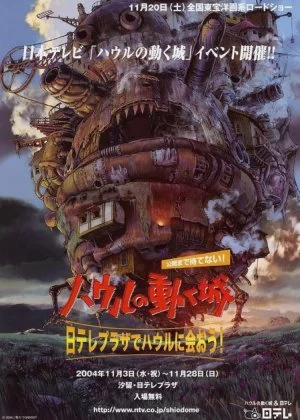Howl's Moving Castle
2004 was a staggering year for Japanese animation. So much in fact that Howl's Moving Castle [Hauru no Ugoku Shiro], the follow-up to Hayao Miyazaki's Oscar-winning Spirited Away, ended up being somewhat of a disappointment amidst the wealth of films that were released that year. Revisiting a film like that years later can be a pretty positive experience as expectations will have leveled off a little, so I was looking forward to giving Howl's Moving Castle another go. I'm still left with some reservations after watching it again, but I definitely enjoyed it more than I did the first time around.
![screen capture of Howl's Moving Castle [Hauru no Ugoku Shiro]](/thumbs/img/articles/1200xauto/howls-moving-castle-1.webp)
Spirited Away was a landmark film for Miyazaki, finally putting him and Ghibli on the map (internationally speaking that is). Anime fans were already very much aware of the studio, but the huge international success never really materialized before Miyazaki's big Oscar triumph. It ended up giving the entire anime scene a boost, which inevitably put Miyazaki at a minor disadvantage. Other studios were finally getting decent budgets to let their creativity roam free, while Miyazaki stuck to his signature style and couldn't help but repeat himself with his follow-up film.
It's no secret that Miyazaki is quite partial to European culture. Films like Kiki's Delivery Service, Porco Rosso and Castle In the Sky wear their European influences on their sleeves. Spirited Away was a thoroughly Japanese film though, so it's not that surprising that Miyazaki opted for a change of scenery and followed it up with a loose adaptation of a European novel (written by Diana Wynne Jones). I've never read the source material, but with the film's Medieval-looking towns, big castles and European-style fantasy elements it's clear that this didn't spring solely from the mind of a Japanese writer.
Sophie's a young girl who spends most of her time constructing hats for her little shop. When she goes out to visit her mom one day, she runs into Howl, a mysterious wizard with a bad reputation. He rescues Sophie from a couple of nasty guards, but by doing so Sophie becomes the target of the Witch of the Waste, one of Howl's adversaries. The witch tracks down Sophie and turns her into an old woman. Sophie can't remain in her village and she sets off, hoping to find someone who can break her curse. That's when she runs into Turnip Head, a scarecrow who escorts her to Howl's castle.
![screen capture of Howl's Moving Castle [Hauru no Ugoku Shiro]](/thumbs/img/articles/1200xauto/howls-moving-castle-2.webp)
If there's one thing you can be sure of when watching a Miyazaki film, it's that the animation will be pretty much flawless. It's obvious that a lot of attention went into even the smallest details, bringing the characters to life through subtle gestures and postures, a feat few other animation houses have mastered. There's a little CG here to help Miyazaki out with the tougher designs (Howl's castle in particular), and there are some added digital effects to simplify the animation work, but for the most part, Howl's Moving Castle is a traditional, hand-drawn wonder of animation. The problem is the art style, which is where things get a little trickier. Die-hard Ghibli fans will love the look of the film, but the lack of stylistic variation between Miyazaki's films is something I find a little disappointing. It doesn't look bad, but it's a bit too expected to really dazzle.
As for the music, I don't think it's Hisaishi's best work. While it's a very capable score, with fairly typical Ghibli melodies that don't detract from the film's more European vibe, it lacks notable and defining pieces that could've lifted the film to a higher level. It's a nice background score that follows the ups and down of the story, but it doesn't really go beyond that, nor does it add anything of itself. It's a good thing then that the dubbing is on point. As always, make sure you get the Japanese dub to avoid lifeless voice work. There's some big acting talent involved (Chieko Baishô does the voice of Sophie and the inimitable Tatsuya Gashûin breathes life into Calcifer) which really helps to further raise the appeal of the characters.
![screen capture of Howl's Moving Castle [Hauru no Ugoku Shiro]](/thumbs/img/articles/1200xauto/howls-moving-castle-3.webp)
While the basics of the plot are quite simple, there is some lore here that feels less obvious. Howl's character (his transformation into a bird and his participation in an ongoing war) are never fully explained and have to be taken for granted. For me it's what makes a fantasy film like this more interesting. When everything feels familiar and/or spoon-fed the genre loses a lot of its wonder and mystery, but I'm sure not everyone will agree with that. Don't worry though, by the end pretty much everything is neatly wrapped up and there are no major threads left hanging, it's just not as clear-cut as some other popular Western fantasy films.
Though revisiting Howl's Moving Castle was fun, and I'm definitely less stern in my critiques compared to 15 years ago, it still doesn't feel like a first-rate Ghibli film. For that it simply doesn't push the boundaries enough (neither in style nor themes). This is all very relative, as even a standard Ghibli film is still well worth your time. The animation is superb, the characters are charming, it's fun to explore its fantasy realm and the pacing is nigh perfect. Good, old-fashioned Ghibli quality in other words. That's not bad considering the hype this film had to live up to. If you like Ghibli films, this one shouldn't be missed.
